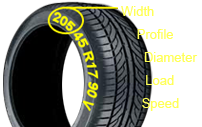Products filtration

SPEED RATING
| Marking | Charactistics |
|---|---|
| Speed Symbol "N" | For vehicles with a speed capability not exceeding 140 Km/h (88 Mph) |
| Speed Symbol "P" | For vehicles with a speed capability not exceeding 150 Km/h (94 Mph) |
| Speed Symbol "Q" | For vehicles with a speed capability not exceeding 160 Km/h (100 Mph) |
| Speed Symbol "R" | For vehicles with a speed capability not exceeding 170 Km/h (106 Mph) |
| Speed Symbol "S" | For vehicles with a speed capability not exceeding 180 Km/h (113 Mph) |
| Speed Symbol "T" | For vehicles with a speed capability not exceeding 190 Km/h (119 Mph) |
| Speed Symbol "U" | For vehicles with a speed capability not exceeding 200 Km/h (125 Mph) |
| Speed Symbol "H" | For vehicles with a speed capability not exceeding 210 Km/h (130 Mph) |
| Speed Symbol "V" | For vehicles with a speed capability not exceeding 240 Km/h (e.g. 225/55 R 15 91V) |
| Speed Symbol "W" | For vehicles having speed capability not exceeding 270 Km/h (e.g. 225/60 R 15 96W) |
| Speed Symbol "Y" | For vehicles having speed capability not exceeding 300 Km/h (e.g. 275/40 R 18 94Y) |
| Speed Category "VR" | For vehicles having speed capability over 210 Km/h (e.g. 195/50 VR 15) |
| Speed Category "ZR" | For vehicles with a speed capability over 240 Km/h (e.g. 205/40 ZR 17) |
| ZR+ Speed Symbol "W" | Tyres marked with both designations for vehicles with speed capability over 240 Km/h but not exceeding 270 Km/h |
| ZR+ Speed Symbol "Y" | Tyres marked with both designations for vehicles with speed capability over 240 Km/h but not exceeding 300 Km/h |
TYRE LOAD RATINGS
| Most car and van tyres used in the UK have both a load and speed rating after the tyre size, e.g. 195/65R15 is usually followed by 91V. This means the tyres can carry a load of 615 kgs upto a maximum speed of 149 mph. When replacing tyres it is important to ensure the new tyres, even if a different size, have the same or a higher load rating. It is normal for the combined load of the 4 tyres to exceed the maximum weight of the vehicle by about 25% to allow for uneven load distribution or excessive loads when cornering or braking. The table below shows the conversion from the LI number to the capacity in kilograms. | |||||||
| Load Index | Kgs | Load Index | Kgs | Load Index | Kgs | Load Index | Kgs |
|---|---|---|---|---|---|---|---|
| 0 | 45 | 30 | 106 | 60 | 250 | 90 | 600 |
| 1 | 46.2 | 31 | 109 | 61 | 257 | 91 | 615 |
| 2 | 47.5 | 32 | 112 | 62 | 165 | 92 | 630 |
| 3 | 48.7 | 33 | 115 | 63 | 272 | 93 | 650 |
| 4 | 50 | 34 | 118 | 64 | 280 | 94 | 670 |
| 5 | 51.5 | 35 | 121 | 65 | 290 | 95 | 690 |
| 6 | 53 | 36 | 125 | 66 | 300 | 96 | 710 |
| 7 | 54.5 | 37 | 128 | 67 | 307 | 97 | 730 |
| 8 | 56 | 38 | 132 | 68 | 315 | 98 | 750 |
| 9 | 58 | 39 | 136 | 69 | 325 | 99 | 775 |
| 10 | 60 | 40 | 140 | 70 | 335 | 100 | 800 |
| 11 | 61.5 | 41 | 145 | 71 | 345 | 101 | 825 |
| 12 | 63 | 42 | 150 | 72 | 355 | 102 | 850 |
| 13 | 65 | 43 | 155 | 73 | 365 | 103 | 875 |
| 14 | 67 | 44 | 160 | 74 | 375 | 104 | 900 |
| 15 | 69 | 45 | 165 | 75 | 387 | 105 | 925 |
| 16 | 71 | 46 | 170 | 76 | 400 | 106 | 950 |
| 17 | 73 | 47 | 175 | 77 | 412 | 107 | 975 |
| 18 | 75 | 48 | 180 | 78 | 425 | 108 | 1000 |
| 19 | 77.5 | 49 | 185 | 79 | 437 | 109 | 1030 |
| 20 | 80 | 50 | 190 | 80 | 450 | 110 | 1060 |
| 21 | 82.5 | 51 | 195 | 81 | 462 | 111 | 1090 |
| 22 | 85 | 52 | 200 | 82 | 475 | 112 | 1120 |
| 23 | 87.5 | 53 | 205 | 83 | 487 | 113 | 1150 |
| 24 | 90 | 54 | 212 | 84 | 500 | 114 | 1180 |
| 25 | 92.5 | 55 | 218 | 85 | 515 | 115 | 1215 |
| 26 | 95 | 56 | 224 | 86 | 530 | 116 | 1250 |
| 27 | 97.5 | 57 | 230 | 87 | 545 | 117 | 1285 |
| 28 | 100 | 58 | 236 | 88 | 560 | 118 | 1320 |
| 29 | 103 | 59 | 243 | 89 | 580 | 119 | 1360 |
| Load Index | Kgs | Load Index | Kgs | Load Index | Kgs | Load Index | Kgs |


Follow us